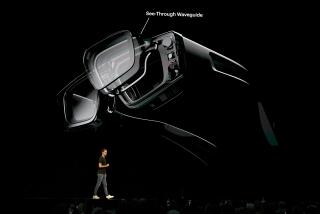Looking out for the poor through water-filled glasses
- Share via
OXFORD, ENGLAND — Joshua Silver, a lifelong tinkerer, was fiddling around one day with a cheap water-filled lens he’d built as an optics experiment when he noticed something interesting.
By adding or removing water he could not only change the power of the lens, but also very accurately correct his own nearsightedness when he looked through it.
“I was struck by the quality of the vision I could get with a device I could make for pennies and I could adjust myself,” said Silver, an Oxford University atomic physicist. “My immediate thought was, ‘If I can correct my own vision so easily, could other people?’ ”
Yes, it turns out. Eyeglasses using Silver’s simple technology are poised to revolutionize vision for the world’s poor -- and quite possibly everyone -- potentially helping billions who struggle to see well enough to farm, study, drive or hold a job.
“With this technology, you can make your own prescription eyewear,” said Silver, who has so far turned out about 30,000 pairs of the cheap glasses. He hopes to find funding to distribute a billion pairs to people around the world who are too poor to afford glasses or who live in places like sub-Saharan Africa, where the ratio of opticians to residents is purportedly 1 to 1 million.
Eyeglass companies are tantalized by the prospect of making glasses that could give wearers the ability to change their prescription with a twist. Goodbye bifocals!
In a world where just about everybody older than 45 needs reading glasses, and just 5% of the world’s poor get the vision correction they need, “the market is close to 3 billion people,” said Silver, 62, who took up the study of optics to better view atomic structure and considers himself a rookie at understanding vision.
Silver’s glasses, now in use in 15 African and East European nations, look like they might pair well with a fake mustache. Thick lenses in dark frames are flanked by a pair of syringes on either temple. By turning dials, the wearer pushes more or less fluid into the lenses, protected between two hard polycarbonate covers, until the prescription is perfect. The syringes can be removed or left in place.
The reaction from new wearers is universal, said Maj. Kevin White, a U.S. Marine Corps logistics expert who persuaded the U.S. Defense Department to buy and hand out 20,000 pairs of the glasses as humanitarian aid in Angola, Georgia and other nations.
“People put them on, they look at a chart on the wall, you see them dialing and suddenly their smirk turns to a smile. They say, ‘Wow! I can see!’ It’s mind-boggling,” White said.
Silver, who went along on the first field test of the glasses in Ghana, remembers how the first man to try a pair, a tailor forced to retire in his 40s when he could no longer see well enough to work, grinned and immediately started up his sewing machine.
“Tears came to my eyes,” Silver said. “I realized how really important it was for a guy like this to be able to see.” He also realized he’d made a strategic error -- no one wanted to give back the prototypes after trying them.
White came across Silver’s invention after watching a Lions Club handout of used glasses in Morocco. Though many people got help, few were able to find glasses that gave them 20/20 vision, he said. He decided there must be a better way. A Google search turned up the self-adjusted glasses. White flew to Oxford for a look and within days had persuaded his superior to place a big order.
“I’ve never seen the military move that fast,” he said. “No one’s a believer until they see them.” The revolutionary glasses have a few drawbacks. They don’t correct astigmatism, but that problem is mild enough in about 80% of potential users that the glasses can still be very effective, Silver said.
Critics also have argued that the do-it-yourself aspect could keep people with eye diseases like glaucoma from visiting doctors who could catch such problems. Silver dismisses that as a major concern, saying that in the locations most likely to benefit from the technology, “there are insufficient professionals and no infrastructure” anyway.
Perhaps the biggest problem is that both the size and price of the glasses are daunting for many: The current model goes for $19. Silver is working on streamlined versions, with hopes of getting the cost down to about $2 as manufacturing volume picks up.
“I’m not in this to make money. I wouldn’t mind making some money,” he said. “But my motivation is to take this technology and get it to people who need it.”
More to Read
Sign up for Essential California
The most important California stories and recommendations in your inbox every morning.
You may occasionally receive promotional content from the Los Angeles Times.









